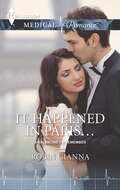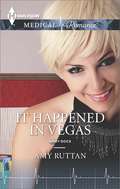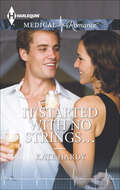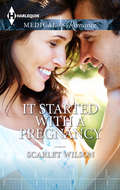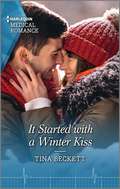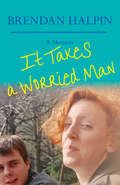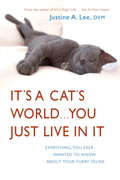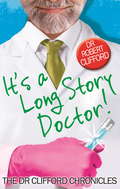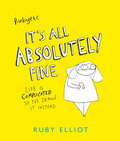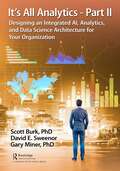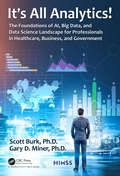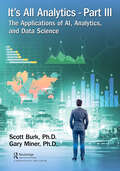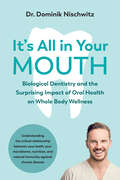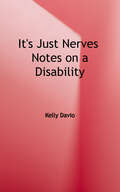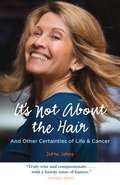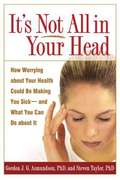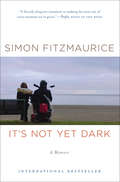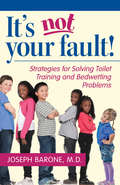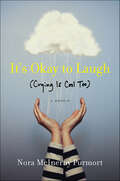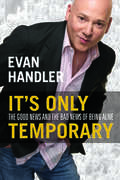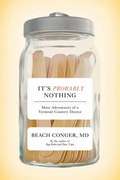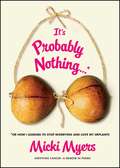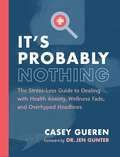- Table View
- List View
It Happened in Paris . . . (A Valentine to Remember #722)
by Robin GiannaWhen work brings a cardiologist to Paris, a Valentine’s Day fling leads to more complicated matters of the heart in this charming medical romance. Avery Girard might have sworn off men, but she can’t help getting swept away by the beauty, magic and romance of Valentine’s Day in Paris . . . especially when she ends up spending it with totally irresistible Dr. Jack Dunbar. One little fling can’t hurt, right? Wrong! After an afternoon of passion, Avery discovers that Jack is actually the cardiologist she is meant to be assessing! And while she’s normally capable of maintaining her professional cool, her heart keeps skipping a beat every time she sees Jack.
It Happened in Vegas
by Amy RuttanThe hero she never forgot... Keeping out of the spotlight isn't easy for senator's daughter Dr. Jennifer Mills...especially after being jilted at the altar by her ex-fiancé! Arriving in Las Vegas, she's just hoping to blend in... But then she meets ER surgeon Nick Rousseau-the same man she spent an unforgettable night with three years earlier! Now returned from Afghanistan, ex-army medic Nick is struggling to come to terms with his time on the front line. Rekindling his romance with Jennifer reminds this brooding doctor that some things in life are still worth fighting for...
It Started with No Strings . . .
by Kate HardyShe can blame one night on the champagne, but what happens after that is the fault of a swoon-worthy coworker who just might heal her broken heart.At a London salsa club, consultant Aaron Hughes catches sight of the most beautiful woman he’s ever seen. Relationships are off the cards for Aaron, but one night with this perfect stranger can’t hurt . . . For registrar Joni Parker, dancing and champagne are a remedy to what-would-have-been-her-wedding-night blues. Until she discovers an even better cure—her first-ever fling! It started with no strings, but when Aaron walks into the hospital on Monday—as the new consultant!—things get a lot more complicated . . .
It Started with a Pregnancy
by Scarlet WilsonDr Cooper Roberts has a new job and the chance to begin a new life. What’s most definitely not in his plans? Waking up with his new colleague, Melissa Bell... And having to hold his head up above the dropped jaws of his fellow docs as he escorts Missy to buy a pregnancy test!
It Started with a Winter Kiss
by Tina BeckettVoted most likely to marry…Will they finally have the chance?Dr. Dexter Chamblisse always has a plan. He just hadn’t planned on an ER reunion with his high school sweetheart, Maura! She may work in his hospital, but Dex has tried to keep his distance. He can’t bear to be reminded of the tragic accident that tore them apart. But it’s getting harder to ignore the sparks still flying between them… Could this be their second-chance Christmas?From Harlequin Medical: Life and love in the world of modern medicine.
It Takes a Worried Man: A Memoir
by Brendan HalpinThis book is a horror story and a comedy, but, most of all, it is a love story written when the author's wife was diagnosed with breast cancer. It is the story of what happens to a man who fears that his best friend might leave him forever.
It Takes a Worried Man: A Memoir
by Brendan HalpinHilarious and heartbreaking, profane and profound, It Takes a Worried Man is the true story of a young husband and father whose life is changed forever by his wife's breast cancer diagnosis. Following Brendan Halpin's cranky, irreverent and lustful thoughts through the diagnosis and treatment of his wife, Kirsten, It Takes a Worried Man is an unflinching and raw look at how cancer transforms a family. It's also the funniest book about cancer you'll ever read.
It's A Cat's World... You Just Live in It: Everything You Ever Wanted to Know About Your Furry Feline
by Justine A. LeeWritten by 1 of only 177 veterinary board-certified emergency critical care specialists in the world, IT'S A CAT'S WORLD is the follow up to Three Rivers' own It's a Dog's Life, But It's Your Carpet. Together, they are the veterinary equivalents of Why Do Men Have Nipples, humorous reference books for pet owners that provide scientific answers to some of the most common, offbeat questions about our beloved four-legged friends. IT'S A CAT'S WORLD will teach you how to become better pet owner through a deeper understanding of your cat, tips and tricks for changing your cats more irksome habits, explanations for kitty's sometimes bizarre (yet adorable) behavior, advice on training your cat, and how best to look out for her health and well-being so you two can be friends for years to come. Most important, Dr. Lee will reveal what your veterinarian wants you to know about being a smart consumer and pet owner. Some of the questions in the book include: How can I make my anti-social cat less fearful? Why do cats knead your lap before lying down? What's the best way to hold a cat? How can I prevent kitty dreadlocks? Written in a fun, humorous tone with equal parts glibness, passion, and professionalism, IT'S A CAT'S WORLD is sure to entertain and surprise even the most well-informed cat lover.
It's A Long Story, Doctor!
by Robert CliffordIn this hilarious omnibus edition of There You Are, Doctor!, On Holiday Again, Doctor? and You're Still a Doctor, Doctor!, we follow everybody's favourite G.P. as he encounters eccentric patients and extraordinary complaints galore. In his charming and delightful style, Dr Robert Clifford brings out the colourful side of medicine, introducing us to Miss Peabody, the elderly spinster ever hopeful of pools to win, and William Jessop, the blind man with a difference! Getting away from it all is not quite the relaxing, welcome break a doctor hopes for as he deals with gastro-enteritis in Marrakesh and kidney stones in Sahara - and the same could be said for the joy of retiring; it seems Dr Bob will always be on call! There's never a dull moments in his company; at home or abroad, his humour and philosophy are a tonic for all.
It's A Long Story, Doctor! (The Dr Clifford Chronicles)
by Dr Robert CliffordIn this hilarious omnibus edition of There You Are, Doctor!, On Holiday Again, Doctor? and You're Still a Doctor, Doctor!, we follow everybody's favourite G.P. as he encounters eccentric patients and extraordinary complaints galore.In his charming and delightful style, Dr Robert Clifford brings out the colourful side of medicine, introducing us to Miss Peabody, the elderly spinster ever hopeful of pools to win, and William Jessop, the blind man with a difference! Getting away from it all is not quite the relaxing, welcome break a doctor hopes for as he deals with gastro-enteritis in Marrakesh and kidney stones in Sahara - and the same could be said for the joy of retiring; it seems Dr Bob will always be on call!There's never a dull moments in his company; at home or abroad, his humour and philosophy are a tonic for all.
It's All Absolutely Fine: Life is complicated, so I've drawn it instead
by Ruby ElliotIT'S ALL ABSOLUTELY FINE is a darkly comic, honest and unapologetic account of daily struggles with mental health and what it's like trying to be a person when you feel like a potato. This book walks readers through the ups, downs and sideways of life, illuminating very real problems, all with Ruby's trademark originality and humour. It's an empowering book that will make you think, make you laugh, and make things that little bit more ok.
It's All Analytics - Part II: Designing an Integrated AI, Analytics, and Data Science Architecture for Your Organization
by Gary Miner Scott Burk David SweenorUp to 70% and even more of corporate Analytics Efforts fail!!! Even after these corporations have made very large investments, in time, talent, and money, in developing what they thought were good data and analytics programs. Why? Because the executives and decision makers and the entire analytics team have not considered the most important aspect of making these analytics efforts successful. In this Book II of "It’s All Analytics!" series, we describe two primary things: 1) What this "most important aspect" consists of, and 2) How to get this "most important aspect" at the center of the analytics effort and thus make your analytics program successful. This Book II in the series is divided into three main parts: Part I, Organizational Design for Success, discusses ……. The need for a complete company / organizational Alignment of the entire company and its analytics team for making its analytics successful. This means attention to the culture – the company culture culture!!! To be successful, the CEO’s and Decision Makers of a company / organization must be fully cognizant of the cultural focus on ‘establishing a center of excellence in analytics’. Simply, "culture – company culture" is the most important aspect of a successful analytics program. The focus must be on innovation, as this is needed by the analytics team to develop successful algorithms that will lead to greater company efficiency and increased profits. Part II, Data Design for Success, discusses ….. Data is the cornerstone of success with analytics. You can have the best analytics algorithms and models available, but if you do not have good data, efforts will at best be mediocre if not a complete failure. This Part II also goes further into data with descriptions of things like Volatile Data Memory Storage and Non-Volatile Data Memory Storage, in addition to things like data structures and data formats, plus considering things like Cluster Computing, Data Swamps, Muddy Data, Data Marts, Enterprise Data Warehouse, Data Reservoirs, and Analytic Sandboxes, and additionally Data Virtualization, Curated Data, Purchased Data, Nascent & Future Data, Supplemental Data, Meaningful Data, GIS (Geographic Information Systems) & Geo Analytics Data, Graph Databases, and Time Series Databases. Part II also considers Data Governance including Data Integrity, Data Security, Data Consistency, Data Confidence, Data Leakage, Data Distribution, and Data Literacy. Part III, Analytics Technology Design for Success, discusses …. Analytics Maturity and aspects of this maturity, like Exploratory Data Analysis, Data Preparation, Feature Engineering, Building Models, Model Evaluation, Model Selection, and Model Deployment. Part III also goes into the nuts and bolts of modern predictive analytics, discussing such terms as AI = Artificial Intelligence, Machine Learning, Deep Learning, and the more traditional aspects of analytics that feed into modern analytics like Statistics, Forecasting, Optimization, and Simulation. Part III also goes into how to Communicate and Act upon Analytics, which includes building a successful Analytics Culture within your company / organization. All-in-all, if your company or organization needs to be successful using analytics, this book will give you the basics of what you need to know to make it happen.
It's All Analytics!: The Foundations of Al, Big Data and Data Science Landscape for Professionals in Healthcare, Business, and Government
by Gary D. Miner Scott BurkIt's All Analytics! The Foundations of AI, Big Data and Data Science Landscape for Professionals in Healthcare, Business, and Government (978-0-367-35968-3, 325690) Professionals are challenged each day by a changing landscape of technology and terminology. In recent history, especially in the last 25 years, there has been an explosion of terms and methods that automate and improve decision-making and operations. One term, "analytics," is an overarching description of a compilation of methodologies. But AI (artificial intelligence), statistics, decision science, and optimization, which have been around for decades, have resurged. Also, things like business intelligence, online analytical processing (OLAP) and many, many more have been born or reborn. How is someone to make sense of all this methodology and terminology? This book, the first in a series of three, provides a look at the foundations of artificial intelligence and analytics and why readers need an unbiased understanding of the subject. The authors include the basics such as algorithms, mental concepts, models, and paradigms in addition to the benefits of machine learning. The book also includes a chapter on data and the various forms of data. The authors wrap up this book with a look at the next frontiers such as applications and designing your environment for success, which segue into the topics of the next two books in the series.
It's All Analytics, Part III: The Applications of AI, Analytics, and Data Science
by Gary Miner Scott BurkProfessionals are challenged each day by a changing landscape of technology and terminology. In recent history, especially the last 25 years, there has been an explosion of terms and methods born that automate and improve decision-making and operations. One term, called "analytics," is an overarching description of a compilation of methodologies. But artificial intelligence (AI), statistics, decision science, and optimization, which have been around for decades, have resurged. Also, things like business intelligence, online analytical processing (OLAP) and many, many more have been born or reborn. How is someone to make sense of all this methodology, terminology? Extending on the foundations introduced in the first book, this book illustrates how professionals in healthcare, business, and government are applying these disciplines, methods, and technologies. The goal of this book is to get leaders and practitioners to start thinking about how they may deploy techniques outside their function or industry into their domain. Application of modern technology into new areas is one of the fastest, most effective ways to improve results. By providing a rich set of examples, this book fosters creativity in the application and use of AI and analytics in innovative ways.
It's All in Your Mouth: Biological Dentistry and the Surprising Impact of Oral Health on Whole Body Wellness
by Dominik NischwitzThe future of medicine—and the key to a healthier life—starts in your mouthAmerican dentists are beginning to discover what some of their European counterparts have long understood: Many common chronic conditions—obesity, inflammation, stroke, diabetes, Alzheimer&’s, heart disease, and cancer, among others—often have their origins in the mouth. In a groundbreaking new work, German dentist Dr. Dominik Nischwitz presents the principles of biological dentistry along with emerging scientific research on the mouth&’s vital role in the body&’s microbiome—a key to whole body wellness.Challenging conventional dental wisdom that views the teeth as separate from the rest of the body, and conventional dental practices that often cause more harm than good, It&’s All in Your Mouth delivers:The latest research on the microbiome and the mouthCritical information on the dangers of root canals and amalgam fillingsThe important role of nutrition in oral health and hygieneA clarion call for a new approach to dentistrySensible, holistic, and humane, It&’s All in Your Mouth offers a necessary new approach to natural immunity to chronic disease and integrating dental hygiene into whole body health.
It's Just Nerves: Notes on a Disability
by Kelly DavioWith equal parts wit and empathy, lived experience and cultural criticism, Kelly Davio's It's Just Nerves: Notes on a Disability explores what it means to live with an illness in our contemporary culture, whether at home or abroad. "When the body attacks itself, the crisis is not just of bones and blood, but of beauty and boundaries. 'Strange men have had their hands on me for days, ' Kelly Davio observes during a plasma treatment. Her skillful portrait of myasthenia gravis does not exist in a vacuum. It's Just Nerves is in keen dialogue with the world around us--critiquing modern health care, pub seating etiquette, alarming election outcomes, smarmy meditation culture, and caricatures of illness in ads and on screen. 'Oxygen is delicious, ' Davio reminds us, before the fire breaks out. A brisk, funny, and at times startlingly poetic memoir." --Sandra Beasley, author of Don't Kill the Birthday Girl: Tales from an Allergic Life. "Kelly Davio's It's Just Nerves feels like the book I've been waiting for all my life. If you want to know what it feels like to be a person with a disability in the 21st century, read this book. From mindfulness to yoga pants, Davio skewers ableist fabrications and brings us to a vital, ebullient, and sometimes terrifying reckoning with our real and shared human experience. She is a very funny writer and also a fearless one. Once I started reading these essays, I couldn't put them down; they resounded through me like poetry or truth." --Sheila Black, author of House of Bone and Love/Iraq. "Kelly Davio's got so much incredible stuff brewing together on every page of these nimble, shapeshifting essays: meditations on the politics of illness, the body in crisis, the spirit in bloom, David Bowie--all of it filtered, carefully, through the lithe sensibility of a poet. The results are equal parts witty and wise, heartrending and rapturous. Man, I loved this book." --Mike Scalise, author of The Brand New Catastrophe.
It's Not About the Hair: And Other Certainties of Life and Cancer
by Debra JarvisDebra Jarvis works as a chaplain supporting patients at Seattle's Cancer Care Alliance (the clinic founded by the world-famous Fred Hutchinson Cancer Research Institute). In that capacity she meets daily with patients in at many points along the path of living with cancer, from diagnosis to treatment to recovery and facing death. So in one of those ironic twists of fate, Jarvis was diagnosed with breast cancer herself. It's Not About the Hair is the account of her time with cancer. As she says, the first thing people ask when they learn you have cancer is whether you are going to lose your hair. But what they really mean to ask is whether you are going to lose your life. Debra Jarvis is able to write honestly and humorously about her experience with cancer because she has had the unique experience of having witnessed and having guided so many cases of cancer. And she brings all of that perspective and context and wisdom to the story of her own breast cancer. As an ordained minister she considers her voice to be a combination of Mr. Miyagi from The Karate Kid" and Martha Stewart (pre-felon, that is), a persona she labels Mr. Martha Miyagi. It's mystical and practical. Debra Jarvis manages to channel a humor that is reminiscent of Nora Ephron. This is a cancer story that won't give you the creeps, but it will guide you to think deeply about the serious stuff like ingrained views on health and disease, life and death, the time we have and how we want to live it.
It's Not All in Your Head
by Steven Taylor Gordon AsmundsonWhere do you go for help when no one believes you're really sick? The doctors can't explain your symptoms, but you know there's something wrong because you can sense it in your body. Living with the specter of an unresolved health issue isn't just painful, it's isolating. The preoccupation and stress it causes can disrupt your career or interfere with personal relationships. If you continually experience symptoms of illness, or worry a lot about disease, you may be suffering from health anxiety--a condition that can produce physical effects of its own, including muscle tension, nausea, and a quickened heart rate. In this compassionate and empowering book, noted psychologists Gordon J. G. Asmundson and Steven Taylor provide simple and accurate self-tests designed to help you understand health anxiety and the role it might be playing in how you feel. Concrete examples and helpful exercises show you how to change thought and behavior patterns that contribute to the aches, pains, and anxiety you're experiencing. The authors also explain how to involve friends and family--and when to seek professional help--as you learn to stay well without worry.
It's Not Yet Dark: A Memoir
by Simon FitzmauriceAn international bestselling memoir about an Irishman who chose to live life to the fullest after his diagnosis of ALS.In 2008, Simon Fitzmaurice was diagnosed with Lou Gehrig&’s disease. He was given four years to live. In 2010, in a state of lung-function collapse, Simon knew with crystal clarity he was not ready to die. Against all prevailing medical opinion, he chose life. Despite the loss of almost all motor function, thanks to miraculous technology, he continued to work, raise his five children, and write this astonishing memoir. It&’s Not Yet Dark is a journey into a life that, though brutally compromised, was lived more fully than most, revealing the potent power of love, of art, and of the human spirit. Written using an eye-gaze computer, this is an unforgettable book about relationships and family, about what connects and separates us as people, and, ultimately, about what it means to be alive.International Bestseller A Barnes & Noble Discover Pick A Barnes & Noble Best Biography of the Year An iBooks Best Book of the MonthAn Amazon Best Memoir of the Month&“A fiercely eloquent testament to making the most out of every moment we&’re given.&”—People, Book of the Week &“Vibrant.&”—Minneapolis Star Tribune&“Beautifully written. Utterly life-affirming.&”—Alan Rickman &“A beautiful love story—in its essence that's what this is. Survival stories are not about surviving, they're inherently about what makes a survivor push through. A desire to remain in the light of all creation, even as a darkening is taking place. A darkening which happens to us all.&”—Colin Farrell
It's Not Your Fault!
by Dr Joseph BaroneMillions of children over the age of five wet their beds every night. Many parents think they must be doing something wrong when their five-year-old is still in diapers while their friends' children are perfectly trained by eighteen months of age. This undoubtedly is a very embarrassing and frustrating problem for both the parent and child, and can interfere with family dynamics and a child's ability to enjoy ordinary social situations. It's Not Your Fault! offers evidence-based strategies for parents who need assistance with toilet training and helping their child with urinary control issues. Dr. Joseph Barone, M.D., provides proven techniques that bring bedwetting to a happy conclusion. Frequently, parents are misguided by bad advice from friends, TV talk shows, the Internet, or parenting books. With many years of clinical experience, Dr. Barone shares valuable, practical information for parents to guide them through the basics of toilet training and bedwetting, and presents management plans to resolve any difficulties that occur. A comprehensive guide, this book covers everything parents need to know about normal toilet training and bedwetting, as well as step-by-step solutions based on testing and research in a real-world setting to help children suffering from delayed toilet training, bed wetting, and daytime urinary wetting.It's Not Your Fault! provides hope and guidance to those desperate to help their children overcome urinary control and toilet training problems. Dr. Barone sets parents on a course that makes things better for both themselves and their children.
It's Okay to Laugh: (Crying Is Cool Too)
by Nora McInerny Purmort“Thank you for the perfect blend of nostalgia-drenched humor, wit, and heartbreak, Nora.” — Mandy Moorecomedy = tragedy + time/roséTwenty-seven-year-old Nora McInerny Purmort bounced from boyfriend to dopey “boyfriend” until she met Aaron—a charismatic art director and comic-book nerd who once made Nora laugh so hard she pulled a muscle. When Aaron was diagnosed with a rare form of brain cancer, they refused to let it limit their love. They got engaged on Aaron’s hospital bed and had a baby boy while he was on chemo. In the period that followed, Nora and Aaron packed fifty years of marriage into the three they got, spending their time on what really matters: Buffy the Vampire Slayer, each other, and Beyoncé. A few months later, Aaron died in Nora’s arms. The obituary they wrote during Aaron’s hospice care revealing his true identity as Spider-Man touched the nation. With It’s Okay to Laugh, Nora puts a young, fresh twist on the subjects of mortality and resilience. What does it actually mean to live your “one wild and precious life” to the fullest? How can a joyful marriage contain more sickness than health? How do you keep going when life kicks you in the junk? In this deeply felt and deeply funny memoir, Nora gives her readers a true gift—permission to struggle, permission to laugh, permission to tell the truth and know that everything will be okay. It’s Okay to Laugh is a love letter to life, in all its messy glory; it reads like a conversation with a close friend, and leaves a trail of glitter in its wake.This book is for people who have been through some shit.This is for people who aren’t sure if they’re saying or doing the right thing (you’re not, but nobody is). This is for people who had their life turned upside down and just learned to live that way. For people who have laughed at a funeral or cried in a grocery store. This is for everyone who wondered what exactly they’re supposed to be doing with their one wild and precious life. I don’t actually have the answer, but if you find out, will you text me?
It's Only Temporary
by Evan HandlerWhat if you were supposed to die, but you didn't? And what if, years later, your precious second chance didn't turn out anything like you thought it would? That's the journey Evan Handler experiences, and the one he explores in It's Only Temporary: The Good News and the Bad News of Being Alive. In a collection of funny, offbeat, and poignant autobiographical essays, Handler moves beyond the supposedly "incurable" illness he triumphed over in his mid-twenties--only to tumble through his thirties and forties in search of ever elusive love and happiness.From bold attempts to rekindle his acting career to hapless efforts to run faster around New York's Central Park reservoir, from bizarre Internet dates to twenty-seven breakups (involving only ten women), Handler careens through his against-all-odds existence. Always searching for meaning in his unlikely survival, he shares stories of sadistic junior high school gym teachers, bullying wannabe Hollywood moguls, returned engagement rings, and Europeans' fascination with American bathroom habits.Picking up ten years after his first book, Time on Fire, Handler again uses what the New York Times calls his "laceratingly funny and revealing" storytelling skills to weave twenty-one new tales into a defiantly unconventional memoir. Consistently witty and insightful, Handler's stories shift effortlessly from the comedic to the profound, musing with equal intensity on the existence of God and his experiences with TV stardom. Then, just when it seems he's failed to make the most of his astonishing second chance, Handler finds his way to miracles even greater than the ones that saved his life. His memoir describes his journey from darkness to light, from yearning to gratitude, and in so doing succeeds as both a stirring love story and a classic coming-of-age tale. It's Only Temporary celebrates the transformation of a boy to man--even if it look Handler more than forty years to get there.
It's Probably Nothing
by Beach CongerIt's Probably Nothing continues the tale woven by Dr. Beach Conger in his first book, Bag Balm and Duct Tape. This new collection sees Conger and his wife yearning for new challenges and relocating to the suburbs of Philadelphia after 25 years in mythical Dumster, Vermont. Conger gamely takes a job in a teaching hospital in the poorest part of the city and gets to experience urban bureaucratized medicine and its trials-a far cry from the more idiosyncratic and hands-on version he practiced in Vermont. After 5 years Conger and his wife move back to Dumster, where he rediscovers more about his patients' capacity to both cope and cherish one another than he expected. Each of the tightly constructed chapters is centered around a particular patient or particular theme in medicine. It's Probably Nothing is both funny and poignant, and showcases both Conger's irreverent view into medicine and his profound empathy for the characters he encounters along the way. His experience highlights how medicine-and problems with our current medical system-can remain the same and yet be vastly different across class, race, and region. Among the people the reader meets are urban drag queens, small-town farmers and other heroes, Vermont celebrities, and the occasional reclusive author.
It's Probably Nothing...*
by Micki MyersDaring, sly, and unlike any other book you've read, this memoir-in-poems tackles cancer with a bawdy wit guaranteed to make you laugh your wig off.As a vibrant woman in her early forties, mother of two, poet, artist, and teacher, Micki Myers decided to confront her cancer diagnosis head on with the sharpest tools in her arsenal: namely, her sense of humor and unbridled poetic license. The result is a charming, poignant, laugh-out-loud collection that hits all the highs (morphine) and lows (everything else) of being a cancer patient and surviving with your spirit intact (even if your boobs are not). It's Probably Nothing... is the perfect gift for a friend in crisis, providing laughter, wisdom, and much-needed perspective. From losing your hair (even, ahem, down there) and gaining two bouncy silicone strangers, to the pitfalls of marijuana therapy and the endless chemo-room muzak "that makes you think/survival might be overrrated," Myers reminds you that you're not alone and that it's okay to laugh.
It's Probably Nothing: The Stress-Less Guide to Dealing with Health Anxiety, Wellness Fads, and Overhyped Headlines
by Casey GuerenFrom stress-induced symptom searching and "miracle cures" to the wellness fads filling your social media timeline, health journalist Casey Gueren digs into why we're so anxious about our health and how to separate medical facts from fiction. Surrounded by &“health hacks&” and clickbait headlines, it&’s easy to feel overwhelmed and underprepared when it comes to taking care of your health. But despite what the wellness industry told you, you don&’t need another cleanse, detox, or supplement—you need a crash course in separating hype from health.In It's Probably Nothing you&’ll find a health journalist&’s tools and tips to. . . Fine-tune your B.S. detector and spot the wellness industry&’s sneaky tricksGet answers to your health questions without spiraling down search holesManage health stress and learn to listen to your body (just enough)Decode the latest overhyped health headlinesFind compassionate, evidence-based care that works for youAnd so much more Packed with illuminating information, funny personal anecdotes, concrete strategies for coping, quotes from dozens of medical experts, and a foreword by New York Times-bestselling author of The Vagina Bible Dr. Jen Gunter, this book is the perfect companion for navigating our wellness-obsessed world with a little less stress and a lot more information.
